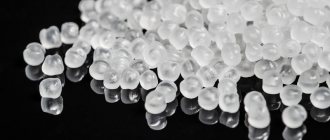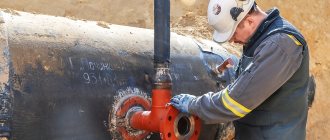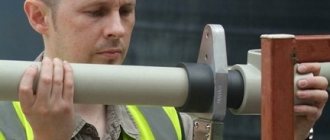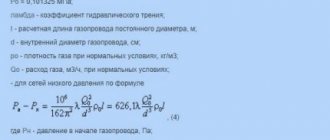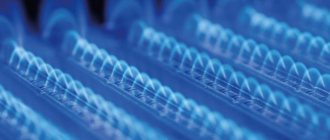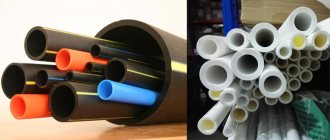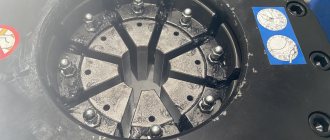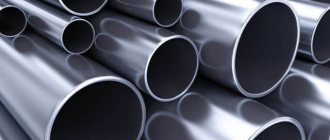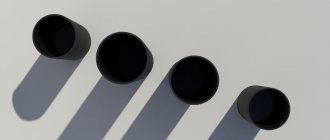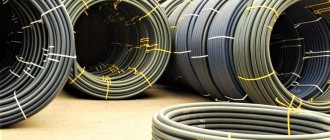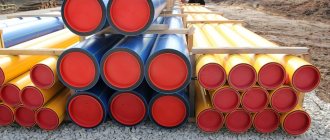Bags made of synthetic materials are used for packaging, storage and sale of products, clothing, shoes, textiles; to popularize a product or service.
One of the most common materials for packaging is polyethylene - thermoplastic, which is characterized by strength, frost resistance, and can withstand heavy weight. Depending on the polymerization rate, there are 3 main types of polyethylene: high, low and medium pressure (linear polyethylene).
Garbage bags LDPE - high-density polyethylene
LDPE (LDPE)
— high-density polyethylene.
Manufacturing process:
Ethylene granules are polymerized in closed apparatus at a temperature of +100...+300 degrees and high pressure up to 300 MPa. The output is a soft elastic material - high-density polyethylene - with a density of 0.918-0.939 g/cm3.
Advantages of LDPE garbage bags:
- High flexibility
- Environmentally friendly and safe for people and animals in direct contact
- Finished LDPE products do not emit toxic substances
- High compressive and tensile strength at low temperatures
- When burned, they release only carbon dioxide and water
- Resistance to mechanical stress
Garbage bags made of high-density polyethylene are produced in accordance with the requirements of GOST 16337-77.
LDPE garbage bags 120 liters 70 microns
Find out the price
LDPE garbage bags 120 liters 50 microns
Find out the price
LDPE garbage bags 120 liters 40 microns
Find out the price
Comparative characteristics of materials
| PVD | HDPE | PSD | |
| density, g/cm3 | 0,91-0,925 | 0,94-0,97 | 0,91-0,93 |
| Tensile yield strength, MPa (50 mm/min) | 8-13 | 10-19 | 10-19 |
| tensile modulus of elasticity, MPa (1 mm/min) | 118-350 | 610-1600 | 200-550 |
| tensile elongation (50 mm/min) | 100-150 % | 600-700 % | more than 50% |
Show video
Garbage bags HDPE – low-density polyethylene.
For its production, a more rigid type of granules is used than for VD polymer.
3 ways to produce low-density polyethylene:
- Polymerization in the gas sector;
- Carrying out reactions in solution;
- Suspensions.
During the production process of raw materials, dyes and stabilizers are added as additives. The finished product has good impact resistance and rigidity with a density of 0.931-0.970 g/cm3.
Features of HDPE garbage bags:
- Low elongation at break
- High strength
- Biological inertia
- At low temperatures and constant load, the dimensions of the finished product change
- Has higher brittleness than LDPE
- Does not allow moisture to pass through
- High dielectric characteristics
- Environmentally safe for humans and animals upon contact.
Garbage bags made of HDPE are manufactured in accordance with the requirements of GOST 16338-85.
HDPE garbage bags 120 liters 50 pieces
Find out the price
HDPE garbage bags 120 liters 10 pieces
Find out the price
HDPE garbage bags 30 liters 30 pieces
Find out the price
Designations, abbreviations
The designations often use a foreign abbreviation standard, which is different from the Russian one in essence. For foreigners, the main criterion is not the pressure at which the granule is made, but the density of the final product. Such a difference in approaches to naming, unfortunately, sometimes leads to some confusion. Judge for yourself:
Russian granules, films and bags of LDPE (high-density polyethylene) correspond to the foreign analogue of LDPE (Low Density Polyethylene - low-density polyethylene)
Russian granules, films and bags of HDPE (low-density polyethylene) correspond to the foreign analogue HDPE (High Density Polyethylene).
Let's compare LDPE and HDPE bags
| LDPE garbage bags | HDPE garbage bags |
External characteristics of the LDPE package:
| External characteristics of the HDPE package:
|
Physical characteristics:
| Physical characteristics:
|
Physical properties
The main raw material for the production of polyethylene film, and, as a result, bags, are polyethylene granules. They are manufactured in large specialized oil refineries by polymerizing ethylene. Differences in the production methods of HDPE and LDPE determine the difference in their physical properties.
Depending on the polymerization conditions (temperature, pressure), polyethylene granules with different chemical and physical properties are obtained.
The first type of granulated polyethylene is High Pressure Polyethylene . It is usually called PVD . These granules, manufactured at high pressure (1000-3000 kg/cm2), have a lower density (about 0.925 g/cm3). The film made from these granules has some tactile resemblance to wax, is relatively transparent, easily stretched, has a large number of cross-links that prevent tearing, is less crystalline, the polymer chains are shorter, melts at a relatively low temperature (103-110°C ).
| Prices for HDPE and LDPE polyethylene over the past 5 years View charts >> | The second type of granules used for film production are HDPE Low Pressure Polyethylene granules . Here, ethylene polymerization occurs under lower pressure conditions (only 1-5 kg/cm2). The density of the resulting substance is higher (0.945 g/cm3). The polymer chains are long, the granule is more crystalline and, as a result, less transparent. Melts at a melting temperature 20-30°C higher than LDPE. As a result, energy consumption during melting is higher, but during operation such a film is able to withstand higher temperatures without breaking. The structure of HDPE allows you to extrude (blow) a film of much smaller thickness. The main difference is that it rustles when crushed. |
Differences between PVD and HDPE
A comparative analysis of the parameters of low- and high-pressure ethylenes shows that HDPE has higher strength characteristics (resistance to chemicals, high temperatures, rigidity and hardness) than LDPE. However, at low temperatures it quickly loses its initial performance. LDPE bags are more suitable for debris with sharp edges and cutting edges, while HDPE bags may split in a straight line due to punctures.
HDPE garbage bags
Find out the price
LDPE garbage bags
Find out the price
Classification
High-density polyethylene can be of different types depending on changes in manufacturing technology. Moreover, it may contain in its mass all kinds of impurities, which are both products of the reaction and residues of related substances:
- Suspension PVP may contain various chemical stabilizers that form a suspension mass of granules during cold polymerization of ethylene. These can be non-aggressive acids, light metal oxides, polymer alcohols and even some types of clay. This plastic is of the highest quality, homogeneous, without structural damage or weak areas.
- Solution polyethylene often contains proportions of catalysts present in the "hot" polymerization reaction.
- Gas-phase contains residues of gases and essential substances. Of all three types, it has the weakest structure, since it is relatively heterogeneous and includes the presence of areas less resistant to wear.
ATTENTION! Due to the presence of foreign elements and substances in HDPE (especially catalysts), it is most often used for industrial purposes, where strength is a more important factor than environmental friendliness and non-toxicity.
What is MDP - medium pressure polyethylene?
There is such a thing as medium pressure polyethylene. This material is a composition of low and high pressure ethylenes. Additional components include stabilizers, which give the final product shine, smoothness and other characteristics. In the production of PSD garbage bags, different proportions of granules are used. Their ratio determines the final properties of the finished products. To give the film greater strength, 5-15% of HDPE granules are added to the LDPE granules. If the bags need to be given greater elasticity and tensile strength, 5-15% of LDPE granules are added to the HDPE granules.
Return to list
Production Features
Manufacturing
HDPE bags are made from granulated polyethylene raw materials using the following methods:
Simple extrusion:- Heating polyethylene to the melting point,
- Extrusion of hot HDPE mass through the annular hole of the extruder to obtain a film sleeve,
- Cooling and application of images with text information, logo, etc.,
- Molding of products in accordance with a specific design of bottoms, side folds, handles (or without them).
- Blown extrusion involves the step of inflating a polyethylene tube into a mold (nip rolls) immediately after it leaves the annular slot of the extruder. At the same time, its diameter increases, the walls become thinner, and their surface becomes less transparent.
INTERESTING! Immediately after extrusion, the film sleeve undergoes a corona process using a special device - a corona machine, which is equipped with almost every extruder. This is done to improve the adhesive properties of the bag in relation to the paint, with which the image is then applied.
Ready-made bags are supplied in rolls with perforations along the tear lines of individual products or in packs of a specific number of pieces (100, 500, etc.).
Classification
Types of packaged products made of low-density polyethylene differ in purpose, have different designs and other design:
- A packaging bag is a product without handles with a wall thickness of 6 to 60 microns, with a sealed bottom or with folds to give it volume. It can be very small for packaging small piece goods or more voluminous (with a side side of up to 600 mm) for industrial and bulk food products.
- The T-shirt bag is made with a thickness of 10-40 microns, has side folds and durable one-piece handles. Can be with a side length of up to 850 mm. Economical, spacious, comfortable to wear and transport. This type of package is most often used for advertising purposes.
- Bags with a die-cut handle are produced with a wall thickness from 6 to 200 microns and a side length of 20 cm and above. Used for packaging various industrial products and food products.
- Garbage bags have a length of up to 4000 mm. They differ from others in their lower price and in that they can be made from recycled materials that are unsuitable for contact with many products.
IMPORTANT! Due to the high strength of HDPE products, die-cut bag handles can withstand very heavy weight, and therefore do not require additional reinforcement, as is the case with LDPE bags.
Advantages of PVD
Polyethylene produced under high pressure conditions is characterized by thermal and chemical stability, low weight and, accordingly, ease of use: these pipes are easier to install and transport.
But despite all its lightness, it is a fairly durable, soft and flexible material that can withstand serious loads:
- deformation and mechanical impact: compression, tension, impacts of varying strength;
- freezing will not cause the pipe to burst;
- chemical attack and corrosion are not dangerous for LDPE pipes;
- the maximum pressure value that is permissible when using LDPE pipes is 25 atmospheres,
- operating temperature - 40°C, in case of accidents - their limit is 80°C.
Peculiarities
The most significant features of corrugated double-wall HDPE/HDPE pipes include:
- simplicity and high speed of installation and dismantling, which does not require complex devices and extensive experience;
- ease of pipe repair during operation; - low cost compared to alternative materials;
- convenience and speed of cable (pipeline) installation inside a corrugated double-wall pipe;
- flexibility, elasticity, and at the same time rigidity, making it easy to lay corrugated pipes along a given path;
- absolute environmental safety for the health of living beings and safety for internal communications due to the chemical inertness and dielectric properties of polyethylene (PE);
- resistance to vibrations and mechanical damage due to durable material - polyethylene, and the special double-wall structure of the pipes;
- a wide range of operating temperatures (from -40 to + 90 degrees C), providing the ability to operate corrugated double-wall HDPE pipes in almost any weather conditions;
- low weight, reducing the cost of storing and transporting pipes;
- long service life of 50 years.
Application
The scope of application of corrugated double-layer HDPE/LDPE pipes is far from limited to the laying of electrical cables.
In fact, any lines of utility networks, including telephone and television cables, heat and gas pipelines and much more, can be reliably protected using HDPE LDPE pipes.
Today, HDPE/LDPE double-wall corrugated pipes are used with great success in a variety of areas of the national economy, including the housing and communal services sector, industrial and military facilities, farms, cottage and country house construction.
Corrugated pipes from the Taygeta company
You can buy corrugated HDPE/LDPE pipes directly from the Taygeta company at the most favorable prices for the customer. Today, the company’s product range includes a line of all common diameters (d) HDPE LDPE corrugated double-wall pipes:
- 40 mm.
- 50 mm.
- 63 mm.
- 75 mm.
- 90 mm.
- 110 mm.
- 125 mm.
- 160 mm.
- 200 mm.
High quality manufacturing, which fully meets European standards, and full compliance of products with Russian standards together are a good guarantee of the reliability of our products over many subsequent years of operation.
For all questions, from price to characteristics of corrugated HDPE pipes, you can contact the managers of the Taygeta company by phone or by leaving a request on our website.
Types of LDPE pipes
Two basic brands of domestic polyethylene serve as raw materials for the manufacture of pipes in accordance with GOST: PVD-108 and PVD-158.
- No. 108 - considered the best material for pipe production. This polyethylene has anti-corrosion properties and is not subject to rotting or destruction.
- No. 158 - used for the manufacture of thin-walled products. The difference between polymers is that the first is a more rigid and durable material, while the second is smoother and contains almost no inclusions.
LDPE pipes differ in diameter and wall size, but, in addition, there are differences in structure; they can be either single-layer or combined, that is, they consist of two types of polyethylene: LDPE and HDPE. For example, two-layer ones - from an external corrugated HDPE layer and a smooth HDPE layer inside, thereby combining the two main properties of each type (strength and flexibility) in one pipe. Three-layer pipes can be additionally reinforced with synthetic thread.
PSD
- PSD is a high-strength solid product.
- Bags made from it are distinguished by their elasticity and shine, and the ability to quickly take the required shape.
- They can protect the contents from exposure to high and low temperatures (down to -30 degrees Celsius).
- They have good impact resistance.
For long-term storage, it is recommended to choose products from PSD and HDPE. If bags are needed for everyday use, they are made from LDPE.
Advice for choosing the required load capacity and thickness. Remember that bags made of HDPE and LDPE will withstand 15 kg with a thickness of 20 microns and 10 microns, respectively. To maintain a weight of 5 kg, a thickness of any polyethylene of 7 microns is sufficient.
